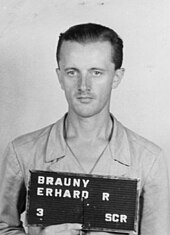Rottleberode subcamp
The satellite camp Rottleberode in Rottleberode was a March 13, 1944 to April 4, 1945 existing satellite camp first of the Buchenwald concentration camp and from October 1944 the concentration camp Mittelbau for about 850 male concentration camp prisoners (November, 1944). This first construction camp of the Mittelbau camp complex was run by the camp SS under the code name "Heinrich".
Function of the camp and prisoners
From mid-March 1944, 200 prisoners transferred from the Buchenwald concentration camp built the Heimkehle plaster cave on behalf of SS Command Staff 5 into an underground factory for Junkers Aircraft and Engine Works (code name Thyrawerk). From the end of July 1944, the inmates had to assemble components for the Junkers Ju 88 and Junkers Ju 188 aircraft on 7,400 m², work on construction sites and were also partly employed in the Uftrungen sawmill .
The mainly Polish, Soviet and French prisoners were housed in a three-story factory building of the Max Schuck porcelain factory, three kilometers from Heimkehle. The ground floor served as storage space, and there were also washrooms and the kitchen. The inmates' bedrooms were on the first and second floors. The building was surrounded by watchtowers and secured with an electrically charged fence. Air force soldiers were deployed to guard .
Particularly after a transport of more than 450 Polish Jews from the dissolved Czestochowa forced labor camp arrived in the Rottleberode subcamp, living conditions there deteriorated in the winter of 1944/45. The inadequate medical care of the prisoners was carried out by a medical officer (SDG), who acted as the camp doctor. In total, around 150 prisoners died during the existence of the satellite camp. In January 1945, the Jewish prisoners who had arrived from the Czestochowa forced labor camp were transferred to the newly established Stempeda satellite camp.
Warehouse management
The first camp leader was the 22-year-old SS-Sturmführer Heinz Grabowski from March to November 1944 and, after a provisional management, from the end of November 1944 to April 1945, the SS-Hauptscharführer Erhard Brauny . Deputy camp leader was Hermann Lamp from November 1944 to February 1945 , who then managed the Stempeda branch until April 1945. Under Brauny and his deputy, the conditions in the camp deteriorated considerably as he assigned brutal prison functionaries to important camp posts and abused inmates. Brauny was sentenced to life imprisonment in the main Nordhausen trial and died in prison. The SDG Paul Maischein , set up from January 1945 to April 1945 , was sentenced to five years in prison in this trial.
Final phase of the camp
From April 4th to 5th, 1945, the Rottleberode and Stempeda satellite camps were evacuated along with a total of around 1,500 prisoners. About 400 prisoners were driven by train and on death marches under camp leader Brauny . At Gardelegen , this group of prisoners met with prisoners from other evacuation transports. Since the evacuation march could not be continued due to the nearby front , more than a thousand prisoners were burned alive in the Isenschnibber barn on April 13, 1945 on the orders of NSDAP district leader Gerhard Thiele .
The other group with around 1,100 prisoners was "evacuated" by train and on death marches under the responsibility of Lamp via the Sachsenhausen concentration camp in a north-west direction. Only a few inmates survived these hardships.
post war period
The former prisoner accommodation on the premises of the porcelain factory no longer exists since the late 1990s. At the entrance to the Heimkehle there has been a memorial stone in memory of the victims of the Rottleberode satellite camp since 2005. On the 70th anniversary of the liberation of the Rottleberode and Stempeda subcamps, a memorial stone was erected at the Waldschlösschen.
literature
- Jens-Christian Wagner (ed.): Mittelbau-Dora concentration camp 1943-1945 . Accompanying volume for the permanent exhibition at the Mittelbau-Dora Concentration Camp Memorial. Wallstein, Göttingen 2007, ISBN 978-3-8353-0118-4 .
- Jens Christian Wagner: Rottleberode subcamp. In: Wolfgang Benz , Barbara Distel (eds.): The place of terror . History of the National Socialist Concentration Camps. Volume 7: Niederhagen / Wewelsburg, Lublin-Majdanek, Arbeitsdorf, Herzogenbusch (Vught), Bergen-Belsen, Mittelbau-Dora. CH Beck, Munich 2008, ISBN 978-3-406-52967-2 .
- Jens-Christian Wagner: Production of death: The Mittelbau-Dora concentration camp , Wallstein Verlag, Göttingen 2001, ISBN 3-89244-439-0 .
Individual evidence
- ↑ a b c d e Jens-Christian Wagner (Ed.): Mittelbau-Dora Concentration Camp 1943-1945 , Göttingen 2007, pp. 199f.
- ↑ a b c d e Jens Christian Wagner: Rottleberode satellite camp. In: Wolfgang Benz , Barbara Distel (eds.): The Place of Terror - History of the National Socialist Concentration Camps , Volume 7, Munich 2008, pp. 330–331.
- ↑ Jens-Christian Wagner: Production of death: Das KZ Mittelbau-Dora , Göttingen 2001, p. 656
- ↑ Event in Rottleberode memorial stone commemorates the people in the subcamp on www.mz-web.de
Coordinates: 51 ° 31 ′ 52 ″ N , 10 ° 56 ′ 47 ″ E
